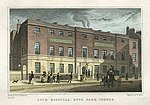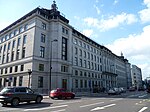Talbot Arms pub bombing
1974 crimes in the United Kingdom1974 in London1974 in Northern IrelandAttacks on bars in the United KingdomBuilding bombings in London ... and 7 more
Explosions in 1974Explosions in EnglandNovember 1974 events in the United KingdomProvisional IRA bombings in EnglandProvisional IRA bombings in LondonPubs in EnglandPubs in London

The Talbot Arms pub bombing took place on 30 November 1974, and was carried out by the Provisional Irish Republican Army (IRA). Eight people were injured in the attack, which involved the IRA throwing homemade bombs through the pub's window. Only one of the devices exploded; the other was taken as evidence and used to discover how the unit assembled its devices.
Excerpt from the Wikipedia article Talbot Arms pub bombing (License: CC BY-SA 3.0, Authors, Images).Talbot Arms pub bombing
Little Chester Street, London Belgravia
Geographical coordinates (GPS) Address Nearby Places Show on map
Geographical coordinates (GPS)
| Latitude | Longitude |
|---|---|
| N 51.4993 ° | E -0.1493 ° |
Address
Little Chester Street 2
SW1X 7AS London, Belgravia
England, United Kingdom
Open on Google Maps









